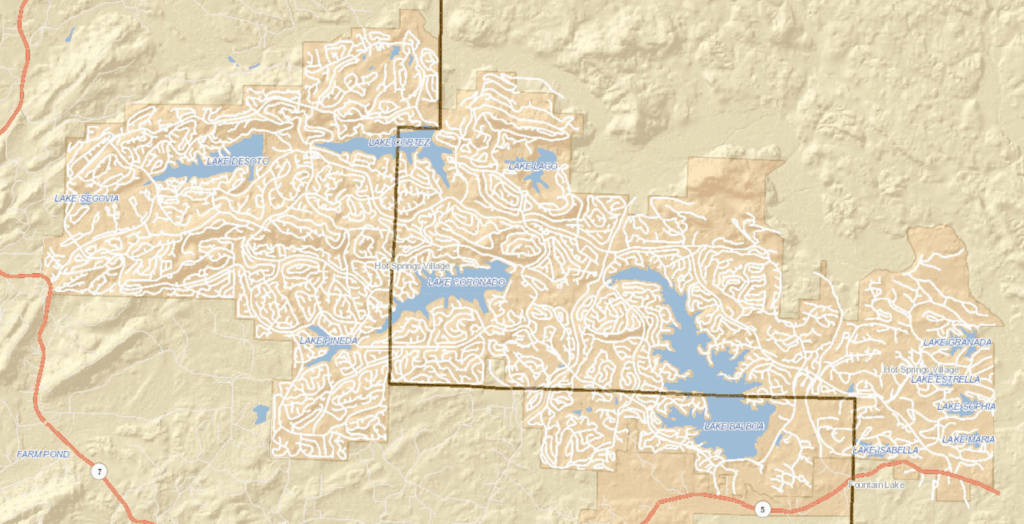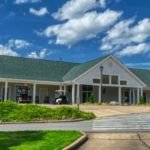Partial Transcription of the HSVPOA CMPAC Meeting on 8/9/19 – Jody Latham speaks
Hot Springs Village Property Owners Association (HSVPOA) Comprehensive Masterplan Advisory Committee met on August 9, 2019. Committee members in attendance were Chairman Keith Keck, Jody Latham, President of Cooper Homes, Patricia McCarthy, Murray Claasen, Pam Avila, Rolland White, Tom Heau, Secretary and Clint Blackman. Also in attendance were Buddy Dixon, Board of Director Liaison and Stephanie Heffer, Staff Liaison (HSVPOA Director of Placemaking and Development).
Dignitaries seated in the audience were Board Members Diana Podawiltz and Nancy Luehring. Lesley Nalley, HSVPOA CEO also attended the meeting.
Jody Latham, President of Cooper Homes talks easements, replatting & more
The conversation transcribed below begins at approximately 47:45 in the YouTube audio recording.
Keith Keck: [Agenda item] 7h, item 7h. Jody’s been gone for a couple sessions there. Just before I turn over…we did the last session for the education moment…I talked about replatting and how it’s kinda…it needs to be a team effort type of thing there and I kind of turned it over to you. We wanted to let you talk about some of the challenges that you see out there.
Jody Latham: Well, first off, and I do understand the importance of language. And if anybody knows me, I have a nickname of “Frank”. I don’t candy-coat anything. So I am just going to tell you how it is. You had given me some items that we both agreed were maybe a challenge. So without going through every single one, I’ll summarize.
Latham: On the Implementation Table, on one point two one, it was Declaration Modify Article four, section one on utilities. We all know it requires the vote of both classes. Obviously, it can be voted on again in 2025. The fact remains, Cooper owns the easements. They are recorded easements. Y’all have heard this over and over again. CCI will do what’s best for the members. Again, we look at what is best for all members, not just the Association. We have to look at what’s best for everybody. That kind of goes on the easements.
Latham: One point two three, Protective Covenants, Modify Section four in zoning. The plats dictate the zoning. Our only concern is when we platted as residential, to come back in and replat portions of commercial, we don’t believe that is what the members want. So again, that would have to be for us to replat or release any easements, it would have to be for the best of all members.
Keck: So would you say residential to residential would be more thinking that way versus…because you said residential/commercial?
Latham: I think there are some questions on, okay, can we go ahead and make this commercial and the people surrounding the commercial area have all voiced, “What are you doing? We thought this was all going to be residential. The plat said, blah, blah, blah.”
Latham: It would have to be, again…
Keck: And that was one of the things that we did, I did the research and we talked about last time is, it’s a three-prong discussion. It’s the POA. It’s Cooper. And it’s…
Latham: Counties…
Keck: Not so much the counties. I went and talked to a county person. They kind of said, “It’s the POA, Cooper, but it’s the subdivisions – the owners in that subdivision.”
Latham: Right
Keck: So that was the third…
Latham: Yes, legally a replat would require every signature on that original plat – the owners of every single…
Keck: The county kind of washed their hands, because I went and talked to Saline County Planning Commission folks and they just said, “That was given to the POA.” So that’s why it is a three-prong type of thing. Just Cooper, POA and all the owners in that subdivision.
Latham: All the owners in that subdivision on the recorded plats. Correct.
Pam Avila: Indecipherable word. Can you explain the easements and how the easements impact any plans for going forward or replatting.
Latham: On the plat and in the Declarations, the Developer kept seven and a half feet on all sides of the lots.
Avila: Of every lot?
Latham: Of every lot. That gave us the ability when more development was happening on the other side, that we had the ability to take utilities through that easement. That was basically the easement for it. So, currently, if there is somebody that is wanting to put a house on top of the easement, the first thing we do is verify, are there any utilities under it? Is there going to be any utilities under it? If we feel comfortable that there would never be and is not any utilities, then we will go ahead and release that easement to that owner. Or possibly give him a license for that easement. But there are some easements that we would want to retain, in the event that utilities have to go through for future growth and so forth.
Latham: So, in order to replat, you would have to…if there is a plat that says, 25 lots on it…You would have to get Cooper to release every single one of those easements if you wanted to make 25 lots into 5 lots.
Avila: Cool. That helps. Thank you.
Latham: If it was for the best of all the members…that’s…I mean we sold every single one of these owners and so we want to make sure that what we are doing serves all the community and not just one specific area.
Latham: The same thing with Protective Covenants, Section seven on the setbacks, I really. I don’t understand the change on that one. In the event of a hardship, it can be changed. I think if you ever had a hardship on a setback, I mean, I guess I am not understanding.
Keck: Here’s a question I have for you because it’s come up outside the Village. What does Cooper interpret…who owns the property under the roads?
Latham: Well, it depends on, if the roads have been dedicated…been deeded. I mean it…
Keck: I’m just curious, because this is an issue that is happening outside the Village right now…that there is an individual who is very vocal about, “I own out to the centerline.” And the Highway Department is getting involved in this type of thing. I just wonder what you thought about…
Latham: The plat designates the right-of-way.
Keck: If you’re looking at it…
Latham: So…
Keck: The plats…if you look in the plats and what’s in the system, may not agree with who owns. That is what we are finding out outside the Village.
Latham: Yes. Because typically when we record the plat, we dedicate, deed to POA or whoever, the road and the right-of-way.
Keck: Okay.
Latham: Now, in Hot Springs, I think we kept the right-of-way on a lot of the different roads. And again, in the event that it is the best for the members…(indecipherable)
Keck: Yes. I was just curious.
Latham: But, I don’t believe this individual owner that owns this lot in front of this road…
Keck: Owns out to the road.
Latham: No. I mean I think it specifies on, I would think on most all plats that we recorded the right-of-way. But I ‘ll definitely do a check.
Keck: I can talk off-line about (indecipherable) because that came up because I thought they did not own, but yes, they technically own out to the middle of the road in this one area.
Latham: I’ll double-check the verbiage on it.
Keck: Because that impacts who owns where and stuff like that, as you start talking in a subdivision. If there ever was to be replatting, if there’s some difference there.
Latham: True. If for some reason, it goes all the way to the road, it would require a lot different replat.
Latham: Bylaws, on some (indecipherable) replats, it is the same story, for the good of all the members.
Latham: One point two one one, POA Policy Move, Chapter four, Article six, Road rights-of-way to the code. I was confused on this one. And I probably should have reached out and gotten a little bit more information, but the current code is missing your street table, in the sense that it wasn’t legible or whatever the street table said. In your Protective Covenants right now, you don’t have a street. It says attached separately for legibility, but there is no attachment.
Keck: Okay.
Latham: So, we just need to correct that first. But I can say that on the newest street that we are building in Maderas, which I just drove by and still don’t have the road base. We were requested to meet county specs. The county specs state “28 feet wide”. This policy states 30 feet wide, minimum. So again, there is some confusion and we need to know what’s going on there. But before we move anything to code.
When the gates go away
Latham: The other thing, when we questioned Jason, “Why do we have to meet county code?” It was stated, “When the gates go away, we want the County to take the roads.” Again, as a Developer, we have major concerns on that.
Keck: Yeah.
Latham: So…
Clint Blackman: Two things…(indecipherable) said this…
Lesley Nalley: Jason stated that to you?
Latham: Jason did. Yes, he did and he’s stated it more than once. You might ask him.
Blackman: And Jason being?
Latham: Temple
Blackman: And what is his position?
Keck: COO – he owns the roads.
Nalley: I don’t remember that being in an email that he sent to you on that.
Latham: You might want to start listening to the conversations because again, he has said it more than once, to us.
Nalley: I will check into that. It certainly wasn’t in writing.
Latham: No it was not.
Keck: Okay. Go ahead. Rolland, you have something.
Rolland White: My impression from all the years on Public Works Committee is none of the roads meet county standards.
Nalley: Yeah, they don’t.
White: So…
Latham: Current county. I am sure it met previous county specs when we built them 40 years ago.
Keck: Previous county standards.
Latham: Obviously Maderas will meet county specs, if we ever get it built.
Latham: Two point three one, POA should consider the use of ground lease agreements and concessions for development of various projects, resorts, hotels. And I believe we discussed this before.
Keck: At your meeting.
Latham: Obviously, we want what is best. We don’t know what, without going into further detail, what would require a vote. If a ground lease is really considered transferring or dedicating property or what, you know. It would just have to…we have to wait and see.
Latham: I am going really fast. Encourage Development of New…two point four four…Encourage Development of New and Diverse Housing. We’re all for it. Bring on. It’s obviously what…Maderas.
Keck: Maderas Gardens
Latham: Encourage higher density, again, I believe that is one area that we need to listen to the members and see if currently if that is something that is wanted.
Keck: But these are the type of things that we can work around, potentially.
Latham: If we felt, again, the Developer is always after what we feel is the majority of the community. I think I could go through all of these…

Keck: That is fine. But, I think the key that we’re getting is, I think a lot of these we can potentially sit down and have a, if we as a CMP say this is important, we can make the recommendation. Then we can turn it over to staff and they can work the issue out there.
Latham: Right.
Keck: But the one, I see this is not limiting our thought right now. Let’s have the thought. Let’s put the recommendation out there and see if it can be worked out and if we make a potential recommendation down the road say, “yeah, this is going to be worked out.” But I don’t want to put you on the spot here, Jody, but I don’t think there is anything that is earth-shattering that we potentially couldn’t work around. If we made a recommendation, that couldn’t be worked around. It may be…it would be a give and take type of thing. That’s kind of how business works, isn’t it? A give and take type of thing?
Latham: Correct.
Keck: Buddy, I don’t want to put anything in the Board’s mouth. We don’t want to handcuff ourself to say this is something we want to recommend and you know the staff and the board say, “It’s good”. And they want to do it, then start doing it.
Latham: Then again, I encourage any input, any marketing details that the community has. Done a survey and they believe we need more Mt Carmel type units, obviously, we have land here…
Keck: I understand.
Latham: We would like to develop it. We really would like to do that. There are two other things, in all of this.
Latham: Establish a POA policy model on transfer Developer rights to control total growth. I can state right now, just so everybody knows. Currently, we have no intentions of selling Developer rights. Currently.
Latham: The other thing and this is kind of Arkansas Real Estate Commission. And I appreciate your showing us the great GIS map [earlier in the meeting Stephanie Heffer gave a presentation of the GIS mapping system]. I have a huge issue that in the CMP, currently the way we have it out there, there are so many areas identified as the “suspend areas”.
Latham: Now according to Arkansas Real Estate Commission, anybody that lists a house or a lot in that area, by law, has to state, did you know the POA is possibly going to suspend growth in that area. And I don’t think we have any realtors in here.
Keck: No realtors today.
Latham: But I think we need to seriously think about that.
Keck: Let’s take that as an action item, Tom. Because then we’ll go and ask the realtors.
Latham: I am a broker. I just went through my whole class and that was part of the fact that anything that you know that is going to impact that. So I think we need to put the suspend on lots that…I understand nonproductive lots. But not group, so that the ones that do have houses in this area, aren’t impacted. Because they, truly, that is like saying you know a highway is coming through. You’ve seen it. It’s on there, so you have to report it.
Nalley: One of the things, as you all know, as we all know, you see comments all throughout the CMP that these are for illustration purposes. Right? So nothing should be assumed, at this point, that anything, real-estate-law wise is actually in suspension. The Board has tasked the staff with bringing forward an actual suspension strategy. And we recognize at that point, then we trigger what you are discussing. I don’t feel like we have triggered it at this point. Everything in there is for illustration purposes.
Keck: But that is something, if we come out and make a recommendation, we want to make sure we are following the law. That is always one of those things.
Nalley: Well, intend to, we don’t intend to take away anyone’s (illegible) rights. So yes, if there is a house if there a property. We’re not looking to suspend anything in those areas we are looking for. We own a ton of properties. So the low-hanging fruit is, areas that don’t make sense. Nobody’s paying on it anyway.
Latham: Right.
Nalley: As opposed to somebody trying to sell it.
Latham: I understand that completely. I am just saying, after spending eight hours [Real estate broker class], the one thing they did state is anything that you see, know, anything about that, you have to report. It may be, I don’t know, but I saw this map and this map says this area is going to be suspended. That is what they are recommending. You know, it may be 20 years. Whatever. I just highly recommend that we try to identify where nobody owns except (indecipherable).
Nalley: Cheryl [Dunson] made that same comment. Cheryl, our broker. We are well aware.
Latham: Those are our major concerns and I would be happy to discuss any other challenges that this committee feels that we have with the Developer.
Keck: Any questions of Jody? I thank you for that because I just wanted…thank you, go ahead.
Blackman: Have y’all dropped the lawsuit against us?
Latham: We won the lawsuit. We sued ourselves. Yes, we won the lawsuit.
Keck: That one’s done.
Blackman: Okay, it’s done.
Latham: So as soon as review all the information that we have requested, then we will probably start on a healthier relationship…
Keck: Thanks Jody.
Transcribed to the best of my ability – Cheryl Dowden












Minn Daly
08/11/2019 — 7:09 pm
Amazeing! Great report! Thank you for letting us know what most of us have suspected that the gates being removed are on the agenda of New CMP plan. If you read on Congressional NEW Urbanism you will see Gates & private subdivisions are not a part of CNU plans for developments. Thank goodness COOPER won & he is sticking with his original developmental plans. This should all be voted on by OWNERS! Not decided by a BOD or committee who do not have majority interest of POA owners. This is really a sad time for A much divided HSV! I have lived here since 1988, past 10 years have been lightly toxic, however the past 3 years ongoing it is very toxic! Respectfully, Minn Daly
HSVP C
08/11/2019 — 7:41 pm
Thanks for your commonsense, Minn Daly. It is a very sad time, indeed.
Mary Szczepaniak
08/12/2019 — 12:15 am
I found it most interesting that Lesley did not refute that Jason Temple said “when the gates go”, only that “it was not in writing.”
One reason that we chose HSV, as seniors, we wanted the gates. I’m sure that most of us feel the same, although, I’m sure most of us would agree, that security does need improvement.
Phil Lemler
08/11/2019 — 7:37 pm
I just find this all so incredible … The CMP was designed with a major “easements” flaw … our board ignored this flaw and passed the CMP anyway. To further dig ourselves out of this poor decision, we have established a CMPAC that just found out about the easements flaw and decides to move ahead anyway and hopes we can find a “work around”.
Meanwhile CCI continues to insist the easements are a CMP implementation impediment. They have been saying this consistently since before the CMP was passed. It doesn’t sound like CCI is interested in any “work arounds”, yet, we … management … the POA board and now the CMPAC committee just closes their eyes and marches on … WOW!
Anonymous
08/11/2019 — 7:39 pm
Phil, you stated it pretty much in a nutshell.
Lorri Street
08/11/2019 — 8:14 pm
Pam Avila: Can you explain the easements and how the easements impact any plans for going forward or replatting.
Latham: On the plat and in the Declarations, the Developer kept seven and a half feet on all sides of the lots.
(Pam)Avila: Of every lot?
(Pam)Avila: Cool. That helps. Thank you.
(Lorri Street comment–“Cool”…How does SOMEONE serving on the CMP Advisory Committee NOT KNOW THIS?!) READ THE HSV DECLARATIONS Pam…oh my…you’re in way over your head)
(Clint) Blackman: And Jason being?
Latham: Temple
Blackman: And what is his position?
Keck: COO – he owns the roads.
(Lorri Street comment–Really? “And what is his position?” Yet ANOTHER person serving on the CMP Advisory Committee completely out of touch–he asked ‘who was Jason’? Simply incredulous!)
Linda Van Scotter
08/11/2019 — 9:25 pm
Lorri, I thought the same thing about knowing about the easements.
I am so angry no ANGRY at kecks comment to ” work around” problems. Oh Lord help us.
They will get so much propaganda out on how wonderful the CMP is.
We need to get ahead of the game on what this CMP really means!!!!
I am sick to my stomach. I want to cry and I really feel even more militant!
I could not believe Blackmon say , “have y’all dropped the lawsuit against us?” What kind of question to Jodi Latham is that?
Thank goodness Jodi had a level head.
Phil Lemler
08/12/2019 — 5:22 am
Additionally, the POA knew these easements were a problem … in the forum conducted by “We the People” in August 2018, I specifically addressed this easement problem. I sent numerous emails to the POA regarding this rather large impediment. I also know that numerous others had expressed the easement problems (as well as many other CMP concerns) before the CMP was approved. They continue to ignore this and sweep the issue under the rug. Now comes the CMPAC … a committee specifically designed to implement the broken CMP … and members of this CMPAC have never been advised about the problem. Hence, the committee member’s surprise to learn about “easements between every lot?” How many meetings has the CMPAC had? And, no one ever even discussed this?
And, the CMPAC’s ultimate decision is “put your head in the sand” …. ignore the obvious and substantial obstacles … and simple move on … hoping that some how it will get magically fixed.
The CMPAC should be disbanded immediately … quit wasting our money … and the CMP should be tabled. A new group should be formed to sit down with CCI and develop a new strategy for HSV that includes sensible development … for things that we need .. working side-by-side with CCI.
It all seem like Don Quixote chasing windmills!
Kirk Denger
08/16/2019 — 9:11 pm
Thank You, Phil, for your leadership.
Jim
08/11/2019 — 9:35 pm
Thank you, Lorri. Our CEO’s half a million-dollar Comprehensive Master Plan is dead in the water. The CEO rolled the dice and decided to demonize CCI to get the proposed Declarations Amendments change… and LOST. CCI controls the easements… A very expensive mistake paid for by HSV property owners…
Myra Sanders
08/13/2019 — 11:29 am
I totally agree with your statement. I seem to know more than Pam and Blackman. Not good.
Monica Impellizzeri
08/11/2019 — 8:31 pm
Exactly right Phil. I’m amazed at how arrogant Leslie Nalley and Keck are!!!
She has such a huge ego!!!!
She has to go!!!!
Pat McCullough
08/11/2019 — 9:12 pm
Folks, I am becoming very much afraid to open anymore of these articles. They are making me more and more Ill. I am now starting to regret the day we moved here. That was over 15 years ago and I am now pretty old and not in very good health. Very difficult for someone in my shoes to pick up and get the hell out of here and I a not willing to lose over $50,000 on our house. And , I am just sick over all of these errors that the Boards have made just because they did not know what in the hell they were doing when getting involved with things the the CMP . Just simply not checking what Cooper still has a grip on here. Now , paying a “CEO” a quarter of a million dollars who is not getting us on some kind of corrective path , but if fact, making it worse. This an absolute nightmare.
Pat McCullough
08/11/2019 — 9:22 pm
Folks, I am becoming very much afraid to open anymore of these articles. They are making me more and more Ill. I am now starting to regret the day we moved here. That was over 15 years ago and I am now pretty old and not in very good health. Very difficult for someone in my shoes to pick up and get the hell out of here and I a not willing to lose over $50,000 on our house. And , I am just sick over all of these errors that the Boards have made just because they did not know what in the hell they were doing when getting involved with things the the CMP . Just simply not checking what Cooper still has a grip on here. Now , paying a “CEO” a quarter of a million dollars who is not getting us on some kind of corrective path , but if fact, making it worse. This an absolute nightmare. I may have made other comments along these lines…….don’t it needs to be said over and over again………Post it.
Anonymous
08/11/2019 — 9:54 pm
Pat, I know where you’re coming from but there is some good articles too.
Max
08/12/2019 — 5:13 am
There are really no gates now, as the policing is so very lax. However, it is good that all can now see that they are planning and have always planned to remove them.
This is really the big issue. Realtors now, by law, have to disclose this knowledge to all prospective buyers that plans are actively in place and being actively promoted to remove the gates. Try that one if you think your property has lost value!!
I have maintained that these people (board, CEO, former board members, etc.) are out of touch with reality. This transcript does nothing but reinforce that notion.
Only two words come to mind after reading the transcript. Unmitigated disaster.
George T
08/12/2019 — 7:30 am
Thank you Cheryl for highlighting these very important comments by Latham.
CCI is looking out for us, so much better than our own leadership.
That is the issue with these committees of board or exboard members, they will hear what they want. These committees should led by the Blakemans, Lemiers or Dowdens, who would listen to the majority as well. Unfortunately I don’t see that happening, nor do I believe these type of committees get anything done.
People need to have a good leader, with experience and skills to lead a place of this size. Not sure if there is anyone really capable of that, but certainly who we have now, falls woefully short. Maybe a management company is the better option as a number of people have suggested, possibly a hybrid of company and our own, focused staff. $17,000,000 plus should buy us something that works! That is what we pay in compensation for our employees today.
George T
08/12/2019 — 7:43 am
Thank you Cheryl for posting this important dialogue between Keck and Latham.
CCI is watching out for us, Keck is not. Now I understand why Nalley has to be at every one of these. So she can hear what is going on in her own organization.
That is the issue with these committees of board or exboard members, they will hear what they want. These committees should led by the Blakemans, Lemiers or Dowdens, who are going to be listening to the majority as well. Unfortunately I don’t see that happening, nor do I believe these type of committees get anything done.
People need to have a good leader, with experience and skills to lead a place of this size. Not sure if there is anyone really capable of that, but certainly who we have now, falls woefully short. Maybe a management company is the better option as a number of people have suggested, possibly a hybrid of company and our own, focused staff. $17,000,000 plus should buy us something that works! That is what we pay in compensation for our employees today.
Jim Langford
08/12/2019 — 8:34 am
First, why is Nalley allowed to interject into dialogue of a committee that she is not on and why is she allowed answer questions about her employees?
Second Jason Temple does not “own” the roads, he is responsible for maintaining them
Bob Busse
08/12/2019 — 10:50 am
Jim Langford is absolutely correct. Why is Nalley , from the audience, allowed to question and answer the committee she is not on? If a member tried to ask a question, they would be reprimanded and ignored, or quite possibly tossed out of the meeting for being a disturbance. Just another case of Nalley throwing her power around and everyone being afraid of standing up to her!
But one of the really important items coming out of this meeting Is the non-denial that the gates are coming down at some point in time! How many time have we heard Nalley and a couple of Directors vehemently deny that there are any plans for the removal of the gate, alluding that we will always have gates. Those are blatant lies knowing that it is the CEO’s plan to implement much of the CMP come hell or high water.
Kathy
08/12/2019 — 12:27 pm
WOW! Great comments! Keck and Nalley need to get off the CMP train!
Max
08/12/2019 — 12:34 pm
That is what I am saying about the disclosure law…won’t realtors now have to disclose that the current POA Board and management have, in fact, a plan to remove the gates? This transcript very clearly indicates that they, in fact, do have that plan and have had it all along. It is only a matter of time.
If realtors don’t disclose this clear plan to remove the gates and then the gates are removed are they not open to legal action?
And will not such a disclosure most certainly negatively effect the property values drastically?
The CMP as written could not ever succeed without the gates being removed as it calls for access by the public in order to even work. But, of course, it will never work as it is simply a plan from another city with far different circumstances. Could anyone ever truly believe this plan could ever work for HSV. It can not. Ever.
This is all too, too much.
Linda Anderson
08/12/2019 — 1:20 pm
The majority BOD/CEO are in lock step to push aside their financial responsibilities to protect and maintain HSV and instead have turned to change our wonderful Village into a ” City ” concept by making the CMPAC Committee the most important avenue for change. The CMP has been placed as a governing document, not just a plan, with all committee’s being attached. It’s about using every means, legal or otherwise, ignoring everything else to push against the reality of CCI’s ownership of easements which were designed to prevent any future organization from changing the original Cooper family belief that this should always remain the ” Greatest Gated Retirement Community”. Mr. Cooper has opened the door to knowing where our money is being spent and standing guard to try to prevent further financial collapse. Now property owners must stop the CMP knowing the real intent is to undermine, remove , and remake this community into a concrete municipality.
George T
08/12/2019 — 2:48 pm
Yes, unfortunately I think you are much closer to reality than anyone will ever admit.
Salaries are out of control, spending is too high for non “core” items…restaurants, reality divisions and overall recreation. Rather than a conservative approach that could appeal to a majority of residents, the leadership wants a home run. We all know that swinging for the fences yields a lot of strike outs. 0 for 1 =CMP, 0 for 2 =improved gate security, 0 for 3 =elaborate swimming pool (in lieu of infrastructure maintenance).
Anonymous
08/12/2019 — 7:55 pm
Lesley must go! Legacy BOD members and newly elected traitor Tormey Campagna are a disgrace to their office.
When the gates come down so will follow our property values.
What a mess.
Lesley must GO!
Anon
08/13/2019 — 1:40 pm
Regarding Ms. Nalley’s disingenuous surprise regarding Jason’s comment about elimination of the Gates, does she think we believe Jason made that up on his own? Sorry Jason, under the bus you go please. We can’t have egg on the CEO’s face.
Kirk Denger
08/13/2019 — 9:49 pm
All members, meet at the next board meeting, the third Wednesday of this and every month to evaluate the HSV BOD and tell those Board members who will not listen to the overwhelming majority of property owners, that we oppose the CMP and that we will replace illegal Board members by a majority vote at a member’s meeting.
Anonymous
08/16/2019 — 11:39 am
Kirk, I’m in on the meeting. I would like Tom Blakeman to address us. Who would others want?
Kirk Denger
08/16/2019 — 9:55 pm
Tom Blakeman is a good spokesperson, Mike, also the statement by Minn Daly, lists respected and credible spokespersons. The spokesperson must be well versed on the precedence set by Glover vs Overstreet, and the simple mistakes that can easily be rectified by the study of the case and the judge’s opinion. Please put our collective minds together and assemble the guardrails that will make this member’s meeting Iron Clad.
Anonymous
08/16/2019 — 12:00 pm
Kirk, would like for Phil limler , Gary puffer, Tom Blakeman & Gene Garner. John Cooper. All Owners who have published facts to this BOD/CEO that they refuse to recognize! Respectfully, Minn Daly
Kirk Denger
08/16/2019 — 10:04 pm
Thank You Minn, you can add Joe Whelen, Office Manager of Cooper Homes, among the many to your list of owners with great interest in the well being of HSV.